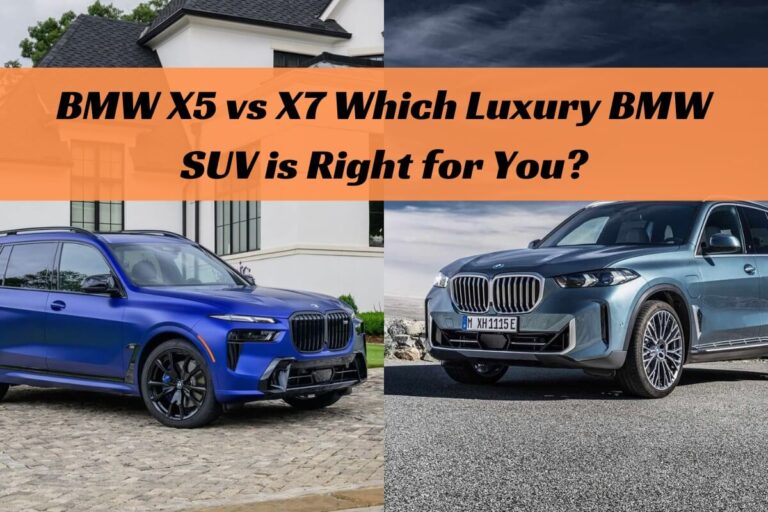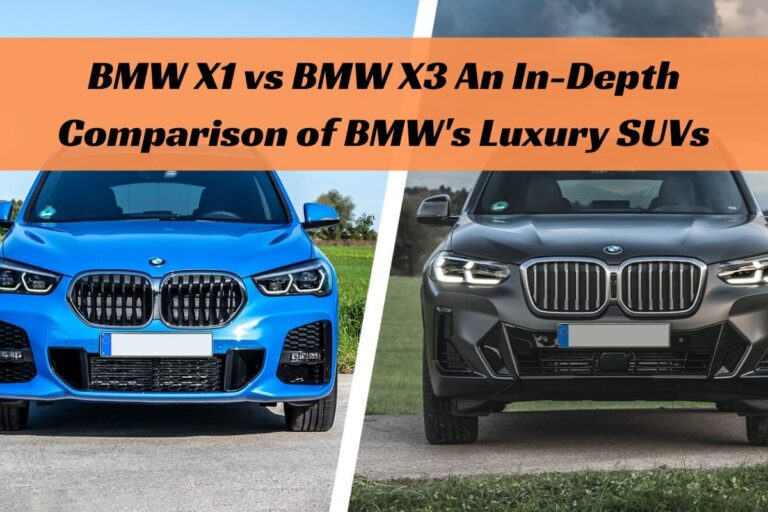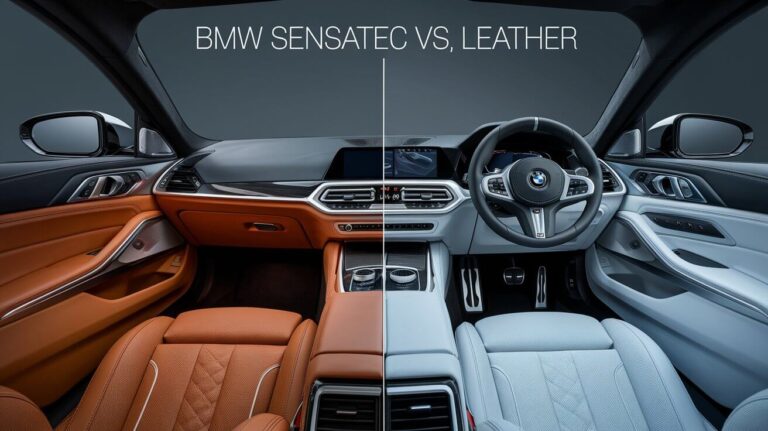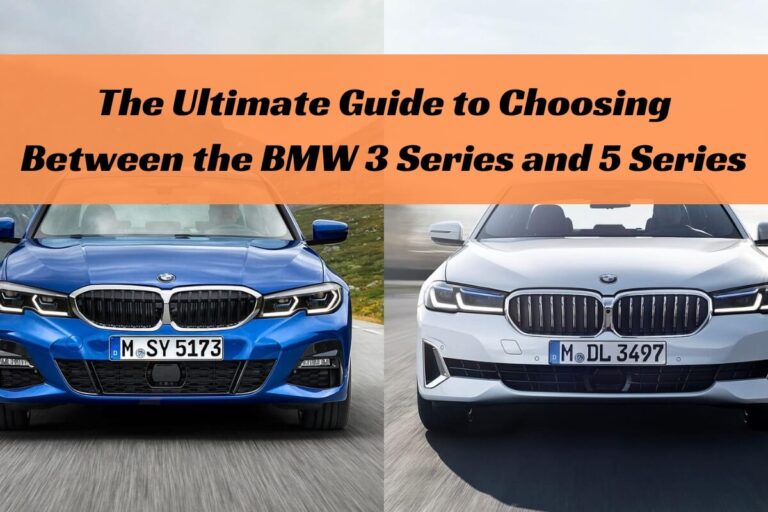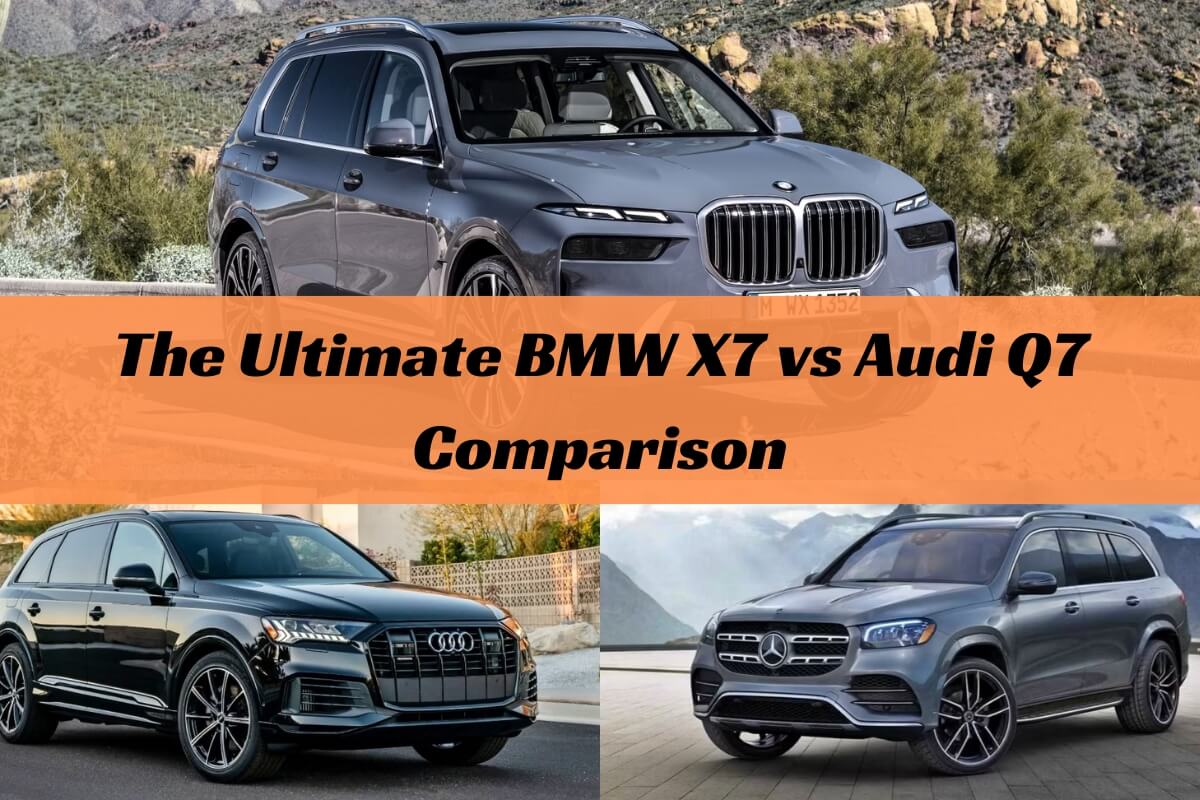
Luxury SUVs have become the ultimate family vehicles, combining premium features, powerful performance, and spacious interiors. Among the most popular choices are the BMW X7 and Audi Q7. But which one is the better choice for you – the BMW X7 or the Audi Q7?
The BMW X7 stands out with a larger size, more powerful engine options, and an edge in cargo space and towing capability. However, the Audi Q7 offers a lower starting price, better fuel efficiency, and arguably a more upscale, tech-focused interior.
In this comprehensive guide, we’ll take a deep dive comparing the BMW X7 and Audi Q7 across all major areas – exterior design, performance, interior amenities, infotainment systems, safety ratings and pricing. By the end, you’ll have all the facts needed to decide which premium three-row luxury SUV best fits your lifestyle and budget.
Exterior Design and Dimensions
The BMW X7 and Audi Q7 both exude a bold, muscular SUV design language. However, each model has its own distinct styling cues and proportions.
The BMW X7 takes on an imposing stance with its larger dimensions. It measures 203.3 inches long, 78.7 inches wide, and 72.2 inches tall, making it one of the biggest luxury SUVs on the market. The X7’s squared-off front end, elongated hood, and chunky character lines give it an unmistakable road presence.
In comparison, the Audi Q7 has a slightly more sculpted, coupe-like profile. At 199.3 inches long, 77.6 inches wide, and 68.5 inches tall, it’s still a sizeable three-row SUV but a bit more compact than the X7. Audi’s signature Singleframe grille and sleek LED lighting elements lend it a modern, sophisticated look.
Both luxury SUVs offer a range of alloy wheel designs up to 22 inches in size. The X7 is available with an optional two-axle air suspension for improved ride comfort and adjustable ride height.
Performance and Powertrain Options
When it comes to performance capabilities, the BMW X7 packs a bigger punch overall. The standard X7 xDrive40i model is powered by a turbocharged 3.0-liter inline six-cylinder engine producing 335 horsepower and 331 lb-ft of torque. BMW estimates a 0-60 mph time of just 5.8 seconds.
For even quicker acceleration, the X7 M60i brings a thundering 523 horsepower and 553 lb-ft of torque from its 4.4-liter twin-turbo V8. This range-topping X7 can rip from 0-60 mph in only 4.5 seconds according to BMW.
The Audi Q7 uses a more fuel-efficient turbocharged 2.0-liter four-cylinder as its base engine, delivering 248 horsepower. While adequate for daily driving, the Q7 45 TFSI Quattro takes a leisurely 6.9 seconds to hit 60 mph from a stop.
Those wanting gutsier performance can opt for the Q7 55 TFSI Quattro which has a 335 hp 3.0-liter turbocharged V6. This V6 Q7 trims the 0-60 mph sprint down to a much faster 5.7 seconds.
In terms of towing, the BMW X7 rates higher with a maximum tow rating of 7,500 lbs when properly equipped. The Audi Q7 tops out at 7,700 lbs of towing capacity.
Fuel economy is one area where the Audi Q7 has an advantage. The four-cylinder Q7 45 TFSI returns an EPA-estimated 19 mpg city and 23 mpg highway. Even the V6 Q7 55 TFSI gets a respectable 17 mpg city and 21 highway.
In comparison, the BMW X7 xDrive40i is rated at 19 mpg city and 24 mpg highway by the EPA, while the thirstier V8-powered X7 M60i drops to just 15 mpg city and 20 mpg highway.
Interior Space and Seating
Both the BMW X7 and Audi Q7 come standard with three rows of seating for up to seven passengers. However, the larger X7 offers more interior room overall.
The BMW X7 provides a generous 41.9 inches of front headroom and a vast 39.8 inches of front legroom. Second-row legroom is a spacious 37.6 inches. Even the third row supplies 33.3 inches of legroom for adults.
Cargo space behind the third row measures a decent 12.8 cubic feet in the X7. Fold the second and third rows flat, and you have a maximum 90.4 cubic feet of cargo volume to work with – one of the highest in this class.
Inside the Audi Q7, there’s still ample room but dimensions are a bit tighter. Front headroom and legroom measure 39.9 inches and 41.7 inches respectively. Second-row legroom is 38.8 inches.
However, third-row occupants have a cramped 29.2 inches of legroom in the Q7, making it less comfortable for adults on longer trips. Cargo space is also smaller, with just 14.2 cubic feet behind the third row and 69.6 cubic feet maximum.
Both luxury SUVs offer premium leather seating surfaces, wood, and aluminum trim accents. Second-row captain’s chairs are optional if you prefer individual seating instead of a bench.
What’s New for 2024?
The 2024 BMW X7 receives a styling refresh with new headlight and grille designs. It also gets updated interior trim options and the latest iDrive 8 infotainment system.
On the 2024 Audi Q7, there are no major changes as it’s in the final year before a complete redesign for 2025. Audi did add some new wheel designs and color options.
Infotainment and Technology
The BMW X7 and Audi Q7 come loaded with the latest infotainment technologies and digital displays. However, each takes a different approach in their control layouts and feature sets.
The X7 features BMW’s iDrive 8 interface with a curved 14.9-inch central touchscreen. It runs the latest iDrive 8 software with improved voice commands. A 12.3-inch digital gauge cluster provides reconfigurable graphics.
Apple CarPlay and Android Auto are both standard, and BMW’s Intelligent Personal Assistant voice control can understand conversational requests. An optional 8K camera system enhances parking assistance and driver awareness.
Inside the Audi Q7, you’ll find the brand’s latest MMI Touch infotainment system with dual central displays – a 10.1-inch upper touchscreen for primary controls, and an 8.6-inch lower touchscreen for climate and vehicle settings. Audi’s sharp 12.3-inch Virtual Cockpit configurable gauge cluster is also included.
The Q7 supports wireless Apple CarPlay and Android Auto smartphone integration. Additional premium features include a head-up display, surround-view camera system, and even a premium Bang & Olufsen 3D audio system.
Both luxury SUVs are packed with the latest driver assistance technologies as well. Standard equipment includes automatic emergency braking, blind spot monitoring, rear cross-traffic alert, lane keeping assist, and more.
Available tech upgrades bring adaptive cruise control with stop & go traffic assist, night vision with pedestrian detection, and semi-autonomous hands-free driving modes for highway situations.
Safety Ratings and Driver Assist Features
When it comes to safety ratings, both the 2023 BMW X7 and 2023 Audi Q7 have performed exceptionally well in crash tests conducted by the National Highway Traffic Safety Administration (NHTSA) and Insurance Institute for Highway Safety (IIHS).
The 2023 X7 earned a five-star overall safety rating from NHTSA, the highest possible score. It received five stars in the frontal and side crash tests and four stars in the rollover evaluation. IIHS named the 2023 X7 a Top Safety Pick+, its highest honor, after earning top “Good” scores across all six crash tests.
As for the 2023 Audi Q7, it was also awarded five stars for overall safety by NHTSA. In IIHS testing, the Q7 received the highest “Good” rating in all six crashworthiness evaluations. However, it did not qualify for the Top Safety Pick+ award due to “Acceptable” ratings for its standard headlight performance.
Both the BMW X7 and Audi Q7 come standard with a full suite of advanced driver assistance technologies aimed at preventing accidents. This includes automatic emergency braking, blind-spot monitoring, rear cross-traffic alert, lane departure warning, and forward collision warning systems.
For additional safety, the X7 offers optional tech like a surround-view camera system, parking assistant, drive recorder, and BMW’s Extended Traffic Jam Assistant for semi-autonomous driving on highways. The Q7 can be equipped with similar upgrades like Audi’s Remote Park Assist and intersection assist.
Pros and Cons of the BMW X7 vs Audi Q7
To summarize some key advantages of each model:
BMW X7 Pros:
- More powerful engine options including a blistering V8
- Larger interior with more third-row and cargo space
- Higher maximum towing capacity
- Superior acceleration and performance
BMW X7 Cons:
- Higher starting price than Q7
- Worse fuel economy ratings
- Some interior controls can be complicated
Audi Q7 Pros:
- Lower starting price for a premium luxury SUV
- Better fuel efficiency across engine choices
- Premium tech like dual touchscreens and virtual cockpit
- Tighter handling and sportier driving dynamics
Audi Q7 Cons:
- Less powerful base 4-cylinder engine
- Less spacious third-row and cargo area
- Not offered with a high-performance V8 engine
Trim Levels and Pricing
The 2023 BMW X7 kicks off around $77,850 for the base xDrive40i model. From there, prices ramp up quickly with additional options and trim levels:
- X7 xDrive40i: $77,850
- X7 M60i: $104,095
- X7 Alpina XB7: $145,995
The 2023 Audi Q7 starts lower at $57,500 for the entry-level Premium quattro:
- Q7 Premium quattro: $57,500
- Q7 Premium Plus: $63,800
- Q7 Prestige: $72,000
When optioning up each model with similar premium packages and tech features, the pricing gap between a loaded X7 and Q7 narrows. However, the BMW does carry a higher luxury price tag overall.
The Verdict – Which One Should You Buy?
At the end of the day, the decision between the BMW X7 and Audi Q7 comes down to your specific priorities and needs for a three-row luxury SUV.
If outright performance, interior space, and towing capacity are most important, the BMW X7 is the pick – especially if opting for the potent M60i model. It delivers immense power from the twin-turbo V8 and has the most expansive interior of the two.
However, if you want the best value luxury while still experiencing premium amenities and tech, the Audi Q7 could be more appealing. With strong performance from the V6 engine and a lower starting price, it’s the more affordable pick for many affluent families.
The Q7 also has sharper driving dynamics that preserve some sportiness despite being a three-row SUV. Audi’s focus on cutting-edge digital displays and innovations gives the Q7’s cabin a slight tech edge too.
Really, you can’t go wrong with either of these excellent luxury SUVs. They both bring tremendous capability wrapped in an upscale package. Do you prioritize the BMW’s performance prowess and spaciousness? Or does the Q7’s blend of value, technology, and handling speak more to you? That will seal the decision.
Frequently Asked Questions
Is the BMW X7 or Audi Q7 more reliable?
Both BMW and Audi have strong reputations for building premium, well-engineered vehicles. However, third-party experts tend to give BMW a slight edge in predicted reliability over Audi. The X7 scores better than the Q7 in model-specific reliability data from sources like J.D. Power and Consumer Reports.
Which has better off-road and towing capability?
While neither the BMW X7 nor Audi Q7 are intended as serious off-roaders, the X7 does have better towing ratings and capabilities. Properly equipped X7 models can tow up to 7,500 lbs, compared to 7,700 lbs for the Audi Q7. The X7’s larger size and optional air suspension also help give it an advantage on rugged terrain.
Which is cheaper to maintain long-term?
Like most European luxury vehicles, the BMW X7 and Audi Q7 won’t be cheap to maintain and repair over the long haul once the factory warranties expire. However, most data suggests the Audi Q7 will cost a bit less to keep on the road than the BMW X7 when it comes to parts, labor, and overall ownership costs.
Which has more interior luxury and tech features?
Both of these flagship SUVs come loaded with premium materials, high-end audio systems, and the latest infotainment technologies from their respective brands. However, the Audi Q7 may have a slight edge in terms of cutting-edge digital displays and avant-garde interior design and controls with its dual touchscreens and virtual cockpit.
Are there any differences in safety ratings?
No, the 2023 BMW X7 and 2023 Audi Q7 have virtually identical safety ratings from NHTSA and IIHS. Both earned five-star overall ratings in government crash testing. The Q7 missed out on an IIHS Top Safety Pick+ award due to lower-rated standard headlights, but otherwise matches the X7’s top “Good” crashworthiness scores.
In summary, while the BMW X7 and Audi Q7 are both exceptional luxury SUV choices, each model caters to slightly different priorities in terms of performance, value, technology focus, and interior space and utility. Consider which factors matter most to fit your lifestyle when deciding between these two premium three-row haulers.



